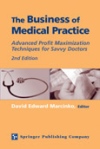The Imperfect Competitive Medical Marketplace
By Dr. David Edward Marcinko; MBA, CMP™
By Hope Rachel Hetico; RN, MHA, CMP™
The issue is not how to fill or reuse empty beds. In this changing environment, hospitals and health systems must focus on streamlining and simplifying operational processes, facilitating case management, promoting the least costly setting for care delivery, and optimizing resource sharing among departments. When hospitals have addressed these issues, then solutions to the “bed problem” will be obvious.
-Cynthia Hayward, 1996
How and why the current healthcare imbroglio happened is very complex, but here is a brief synopsis of current supply-demand inequalities.
A Definition of Medical Care
Medical care is defined as the finite examination and treatment of patients, for monetary compensation. Among other reasons, changes in patient demand may occur as a result of the absence or presence of health insurance plans or the encouragement of additional treatments by profit maximizing providers.
Health Economics 101
Changes in supply occur as a result of physician shortages or surpluses and a host of other factors. Until recently, a glut of physicians has caused them to become “price takers,” selling a homogenous service.
How else could aggregate HMO fee schedules drop to some percentage below prevailing Medicare or Medicaid rates in some instances? Or, how else could otherwise qualified physicians be de-selected from managed healthcare plans because of large (successful equates with expensive) practices?
The Supply-Demand Curve
A graphical representation of this economic relationship produces the classic downward sloping demand curve and the upward sloping supply curve. At some point in time however, the treatment plan is completed, the patient is satisfied, and additional services are not needed. This is known as market equilibrium.
When an industry becomes more competitive – either by too much supply or too little demand – market equilibrium fees tend to become elastic while patient volume becomes very sensitive to even small changes in price. This may be where we have arrived, right now relative to medical price elasticity.
Medical Price Elasticity
In a managed care environment, every covered service has a low price ceiling and every “non-covered” service has its own price elasticity.
Traditionally, medical services were inelastic to price changes and considered a growth industry since a fee increase would also increase revenues. Now, the marketplace has become resistant to pricing pressure by physician oversupply and managed care.
Generally, a pricing coefficient greater than one is considered elastic, while a coefficient less than one is inelastic.
Interestingly, exact unity prevails when elasticity of supply is exactly equal to one.
In the golden days of medicine, the price elasticity of medical care was greater than 1, now it is about .35 and diminishing
Meaning to Doctors
Financially, all this means that many doctors are “taking what they’re given (by HMOs, CMS, etc), because they’re working for a living”.
Younger doctors under 40 are especially inclined to work for less since they have had little exposure to fee-for-service compensation. Older doctors are retiring. Middle-Agers are frustrated.
Additionally, physicians have an increasingly smaller share of the medical marketplace because of so-called medical care extenders, such as PAs and nurse practitioner’s.
Some health plans have even done away with many true allied healthcare professionals, such as RN’s or CRNAs, in favor of trained, not educated, and less costly technicians.
Conclusion

Despite the financial impact of managed care on doctors, patients may also be hurt physically as the economic cost of medical re-intervention is often much more than the cost of the proposed initial professional care.
For example, a study by Deloitte & Touche a few years ago, reported employee satisfaction was decreasing about 10 percent per year, as healthcare coverage represented a fiscal and economic time bomb on corporate books.
How would you comment on the above in light of the IOM on medical errors and mistakes, findings a few years back?
Link: http://feeds.feedburner.com/HealthcareFinancialsthePostForcxos
Speaker: If you need a moderator or speaker for an upcoming event, Dr. David E. Marcinko; MBA – Publisher-in-Chief of the Medical Executive-Post – is available for seminar or speaking engagements. Contact: MarcinkoAdvisors@msn.com
OUR OTHER PRINT BOOKS AND RELATED INFORMATION SOURCES:
DICTIONARIES: http://www.springerpub.com/Search/marcinko
PHYSICIANS: www.MedicalBusinessAdvisors.com
PRACTICES: www.BusinessofMedicalPractice.com
HOSPITALS: http://www.crcpress.com/product/isbn/9781466558731
CLINICS: http://www.crcpress.com/product/isbn/9781439879900
BLOG: www.MedicalExecutivePost.com
FINANCE: Financial Planning for Physicians and Advisors
INSURANCE: Risk Management and Insurance Strategies for Physicians and Advisors




Filed under: Health Economics, Health Insurance, Healthcare Finance, Managed Care, Practice Management | Tagged: CMS, competition, CRNA, health competition, Health Economics, HMO, medical supply-demand, non-covered medical care, price elasticity, RN | 10 Comments »



















